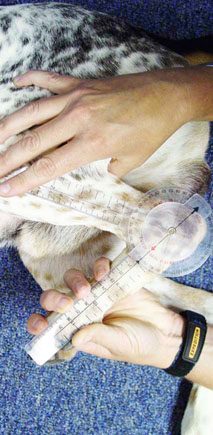David Levine, Denis J. Marcellin-Little, Marti Drum and Cassy Englert Physical therapy is a profession with an established scientific basis in humans and companion animals. It has numerous clinical applications in the restoration, maintenance, and promotion of optimal physical function.1 It is beneficial in helping people recover from anterior cruciate ligament reconstruction, fracture stabilization, joint surgery, spinal surgery, and many other injuries or diseases.2–5 It also improves function in a variety of patients with soft tissue injuries, osteoarthritis, total joint arthroplasty, stroke, and chronic lower back pain throughout their lives.6–10 In providing physical therapy the goal is to restore, maintain, and promote optimal function, optimal fitness, wellness, and quality of life as they relate to movement disorders and health. In dogs, this may include treating patients during their recovery from orthopedic surgical procedures, such as femoral head ostectomy, monitoring weight loss programs, strengthening specific muscle groups, and helping to manage chronic conditions, such as osteoarthritis, or progressive conditions, such as degenerative myelopathy. A major emphasis is to prevent or minimize the onset, clinical signs, and progression of impairments, functional limitations, and disabilities that may result from diseases, disorders, conditions, and injuries. Examples in people include designing and delivering treatment programs for patients with problems such as pneumonia, multiple sclerosis, diabetes, cerebral palsy, lower back pain, or frozen shoulders.1,11–14 Physical therapists use a variety of treatment interventions such as stretching, targeted massage, passive range of motion, and joint mobilization. They also use electrical and thermal modalities and therapeutic exercises to help patients reach their goals. These treatments work synergistically to effectively achieve the therapeutic goals. When designing a treatment plan, the therapist should be aware of the scientific evidence supporting the use of each modality and exercise for the problems being treated. For example, when treating postoperative edema, ice has been proved to be beneficial,15 whereas certain other therapies are unproven. The therapist should integrate the individual treatment plan with established perioperative and postoperative pain management protocols. Although the clinical signs present in many dogs with orthopedic or neurologic problems may improve over time, such as after fracture repair, a well-designed physical rehabilitation program may accelerate the recovery, may prevent permanent disability, and may help prevent future re-injuries. The physical rehabilitation evaluation involves the evaluation of active motion during various gaits and while performing specific activities, such as stair climbing. The dog should be evaluated at a walk, trot, and gallop if the patient is able and it is safe to do so. The evaluation also includes the assessment of function at rest, including posture, balance, and strength. Balance may be assessed by performing various perturbation maneuvers such as pushing the dog off balance and assessing the dog’s response. Balance is further tested by evaluating overall coordination, gait, and whether or not the patient falls. Proprioception during ambulation is tested by evaluating toe dragging, knuckling, awkward stepping, and limb carriage and placement. Strength is tested by evaluating muscle mass and the ability to perform normal activities. For example, hip extensor strength may be assessed by observing the dog when it rises. The evaluation continues with assessment of pain and motion of joints. The therapist evaluates discomfort and the condition of injured and abnormal tissues, such as excessive laxity or restriction of motion as a result of scar formation (Table 12-1). The therapist collects this information to understand how these limitations affect function and how they may be targeted during therapy. Table 12-1 Specific Tissue Assessments during the Physical Rehabilitation Evaluation
The Physical Rehabilitation Evaluation

Treatment Philosophy
Physical Rehabilitation Evaluation
Tissue
Parameters
Anomalies
Potential Causes
Muscle
Mass/size
Atrophy
Denervation, disuse, contractures
Hypertrophy
Increased training and conditioning
Increased
Edema, hematomas, neoplasia
Tone
Increased
Spasm, guarding, denervation (upper motor neuron)
Decreased
Denervation (lower motor neuron)
Pain
Acute pain
Tear, myositis, spasm
Chronic pain
Tear, contracture, spasm, referred neurogenic pain
Tendon
Pain
Acute pain
Tendonitis, strain
Chronic pain
Tendonitis
Tension
Increased
Adhesion, contracture
Joints
Motion
Loss
Contracture, periarticular fibrosis or adhesions, effusion
Abnormal
Subluxation, luxation
Pain
Acute pain
Subluxation, luxation, infection
Chronic pain
Osteoarthritis
Ligaments
Stability
Decreased
Sprain, rupture
Increased
Adhesion, contracture
Pain
Acute pain
Sprain
Chronic pain
Adhesion ![]()
Stay updated, free articles. Join our Telegram channel

Full access? Get Clinical Tree


The Physical Rehabilitation Evaluation
Only gold members can continue reading. Log In or Register to continue
